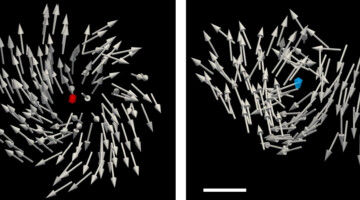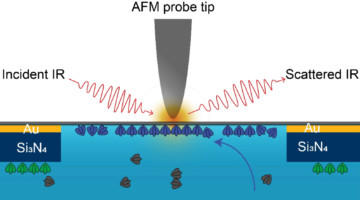Hybrid supercapacitors (HSCs) integrate the merits of batteries with those of supercapacitors. However, the fraction of active material in HSC electrodes has remained too low for commercial requirements. Now, researchers have found a clever way to increase the active-mass ratio to achieve dramatic improvements in key measures. Read more »
Extreme Closeup of Copper Electrocatalysts in Action
Researchers at Berkeley Lab have made real-time movies of copper nanoparticles as they evolve to convert carbon dioxide and water into renewable fuels and chemicals. Their new insights could help advance the next generation of solar fuels. Read more »
Imaging Topological Magnetic Monopoles in 3D
Researchers created topologically stable magnetic monopoles and imaged them in 3D with unprecedented spatial resolution using a technique developed at the ALS. The work enables the study of magnetic monopole behavior for both fundamental interest and potential use in information storage and transport applications. Read more »![]()
![]()
Electric Vehicle Batteries Could Get Big Boost With New Polymer Coating
Scientists have developed a conductive polymer coating—called HOS-PFM—that conducts both electrons and ions at the same time. This ensures battery stability and high charge/discharge rates while enhancing battery life. The coating also shows promise as a battery adhesive that could extend the lifetime of a lithium-ion battery from an average of 10 years to about 15 years. Read more »
How a Record-Breaking Copper Catalyst Converts CO2 Into Liquid Fuels
Scientists know that copper has a special ability to transform CO2 into valuable chemicals and fuels. But for many years, they struggled to understand how. Now, a research team has gained new insight by capturing real-time movies of copper nanoparticles as they convert CO2 and water into renewable fuels and chemicals: ethylene, ethanol, and propanol, among others. Read more »
Structural Investigation of Therapeutic Antibodies Using Hydroxyl Radical Protein Footprinting Methods
Well-known high-resolution structural methods are often used to characterize antibody structures, but many require specialized sample preparation that may perturb antibody structure. We describe here the relatively new method of hydroxyl radical protein footprinting, a solution-state method that can provide structural and kinetic information on antibodies or antibody–antigen interactions useful for therapeutic antibody design. Read more »
A Nano-IR Probe for Proteins in Liquid Environments
A new technique using infrared (IR) light revealed how the self-assembly of proteins is affected by environmental conditions in a surrounding liquid. This nanoscale probe of soft matter in a liquid matrix will facilitate advances in biology, plastics processing, and energy-relevant applications such as electrocatalysts and batteries. Read more »![]()
![]()
A New Material System for Mixed-Plastic Recycling
Scientists have designed a new material system to overcome one of the biggest challenges in recycling consumer products: mixed-plastic recycling. Their achievement will help enable a much broader range of fully recyclable plastic products and brings into reach an efficient circular economy for durable goods like automobiles. Read more »
Scientists Grow Lead-Free Solar Material With a Built-In Switch
A new ferroelectric material—grown in the lab from cesium germanium tribromide (CGB)—opens the door to an easier approach to making solar cell devices. Unlike conventional solar materials, CGB crystals are inherently polarized, where one side of the crystal builds up positive charges and the other side builds up negative charges, no doping required. Read more »
Multilayer Stack Opens Door to Low-Power Electronics
Researchers found that a multilayer stack of ultrathin materials exhibits a phenomenon called negative capacitance, which reduces the voltage required for transistor operation. The material is fully compatible with today’s silicon-based technology and is capable of reducing power consumption without sacrificing transistor size or performance. Read more »![]()
![]()
- « Previous Page
- 1
- 2
- 3
- 4
- 5
- …
- 10
- Next Page »









